Tourism in Albania is characterized by archaeological heritage from
Illyrian, Greek, Roman and Ottoman times, unspoiled beaches, mountainous topography, delicious traditional Albanian cuisine, Cold War era artifacts, unique traditions and hospitality, and the wild and peculiar atmosphere of the countryside. In 2014, the New York Times ranked Albania fourth among 52 destinations to be visited.[1] Although still underdeveloped, Albania is set to prime its debut on the world scene as it celebrates a century of independence.[2] Lonely Planet ranked Albania as the no. 1 destination to be visited in 2011.[3] A Huffington Post article outlined 10 reasons for visiting Albania in 2013.[4] Recently, Albania has been officially dubbed as "Go Your Own Way". Previously, it was dubbed as "A New Mediterranean Love" and "Europe's Last Secret".[5]
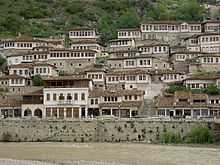
World Heritage Site of
Berat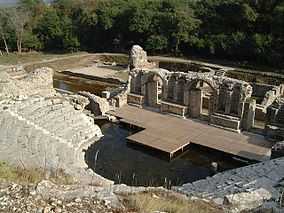
Ancient Amphitheater of Butrint
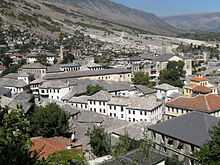
Gjirokaster, the city of stone
The bulk of international tourists going to Albania are from Kosovo, Macedonia, Montenegro, Greece , and Italy.[6] Foreign tourists mostly come from Central and Eastern Europe, particularly from Poland, Hungary, and the Czech Republic. Tourists also come from Western European countries such as Germany, Belgium, Netherlands, France, UK, Scandinavia, and others including the United States, Turkey and countries in Asia.[7] To better enjoy ones's stay and for useful information, first time travelers to Albania are strongly encouraged to consult online/print publications, travel forums and blogs on specific tips and itinerary, or can simply book a tour with a local tour operator. Some travelers include Albania as part of the wider Balkan tour package. Backpackers are common and prefer resting at hostels, camping in the countryside or along the coast. Organized groups visit the numerous archaeological sites, historic towns, or rest at seaside resorts. A growing trend has become canyon rafting, bird-watching, cycling, mountain biking, hiking, and off-road touring in the countryside. Other travelers enjoy exploring the trendy area of Blloku, Tirana's entertainment district which transfers along the Albanian Riviera during the peak summer months. Car rental agencies, tour operators, and tourist information centers have opened branches in the capital and other towns. Dental tourism has become popular as local dentists offer services with much lower prices. Local delicious cuisine can be tasted at traditional Albanian restaurants located in emerging agrotourism areas, near tourist attractions, and in scenic spots throughout the country.
However, tourism is hampered by local management issues such as poor road and public utilities infrastructure, unregulated waste disposal, illegal construction and hunting, uncertain land ownership, and an unqualified hospitality sector. These are due to Albania's long isolation, but are being dealt with and improvement is being seen constantly. Most main and coastal roads, some mountainous ones, and water supply and treatment facilities have been recently reconstructed mainly through IPA pre-accession funds to the European Union. The private sector and foreign donors are heavily investing in accommodation and renovations at historical sites, seasonal charter flights are increasing, while others are expressing interest and investing in building tourist resorts and marinas.
General Information
- Flag: Black double-headed eagle on red background
- International telephone prefix: +355
- Government: Parliamentary Democracy
- Population: 2,821,977 inhabitants (according to 2011 Census)
- Area: 28,748 km2
- Capital city: Tirana
- Language: Albanian, Greek & Italian with English as a foreign language
- Currency: Lekë
Official Holidays
Albania has other holidays as well but may not be official state recognised bank holidays as the above. Albanian Counties may have local holidays such as Greek National Day in Himara, that are not officially celebrated by the central government.
Religious Coexistence
In Albania, there is a peaceful coexistence of those practicing a variety of religious faiths. Muslims, Orthodox, and those following the teachings of the Catholic Church comprise the majority of people adherent to religion. In 1967, religious worship was prohibited and the country became the world’s only official atheist state. Since the end of the Communism,
Albanians have been guaranteed the freedom of religion and have exercised that freedom in various ways.
Towns and archaeological sites
Stemming from a rich history of civilizations, Albania holds a mix of interesting artifacts. Since 2013, town centers in Albania are being redesigned and facades painted to reflect a more Mediterranean look. The most visited towns are:
The most visited archaeological sites are
UNESCO World Heritage Sites
Albania is home to two World Heritage Sites (Berat and Gjirokastër are listed together)
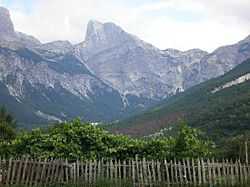
The Wild Albanian Alps in Northern Albania
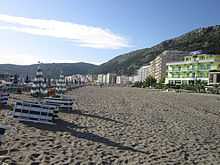
Curative beach sands of Shengjin in the north
Natural attractions and emerging agritourism areas
Northern Albania
Northern Albania is known for its alpine mountainous landscape, conservative highlands, large hydroelectric reservoirs, and where the southern most glaciers of Europe are located. Some increasingly popular features include:
- Albanian Alps, part of the Prokletije or Accursed Mountains range in Northern Albania bearing the highest mountain peak. Kelmend region is located on the northernmost point of Albania.
- Lake Komani Ferry, a unique journey amidst spectacular mountain views
- Emerging agritourism area of Puka, panoramic Ulza Lake, Fishte area of Bushat near Lezhe, Shishtavec in Kukes County, and alpine area of Nikaj-Mertur in Lekbibaj region near Bajram Curri
- Fishing village of Shiroka along Shkodër Lake
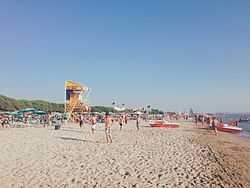
Golem beach south of Durres. Other coastal retreats can also be found around Durres.
Coastal western lowland of Albania
The western lowland of Albania alternates between archaeological sites, castles, long stretches of curative sandy beaches, and lagoon areas perfect for bird-watching. In total, the coastline of Albania stretches over 362 km[8] and is administered by the AKB National Coastal Agency. Some emerging coastal areas include:
- Curative beaches of coastal Shengjin near Lezhe, and Velipoja close to Ada Bojana near the Montenegrin border
- Coastal areas of Lalzi Bay north of Durrës near Rodon Cape, Golem Beach south of Durres, and General's Beach near Kavaje
- Kune-Vain Lagoon near Lezhe, and Karavasta Lagoon near Divjake along the Adriatic Sea
- Picturesque areas of Fushe-Kuqe and Shenkoll near the Kune-Vain-Tale Lagoon Area
- Protected coastal area of Pishe-Poro in the Vjosa River Delta near Narta Lagoon featuring bird-watching, sand dunes and medicinal herbs
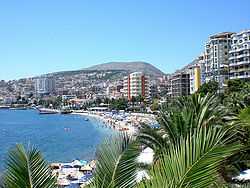
Seaside town of Saranda across from
Corfu
Turquoise beaches in Radhima south of Vlora and down along the Albania Riviera
Central Albania
Central Albania alternates between hilly and mountainous topography, ancient castles and rich culinary traditions of rural Tirana, Elbasan, and Gramsh.
Southern and Southeastern Albania
Southern and Southeastern Albania are mostly mountainous and known for UNESCO World Heritage Sites, and long stretches of shingle and sandy beaches along the Albanian Riviera and Lake Ohrid.
- Albanian Riviera, the coastal area stretching from Vlorë to Saranda along the Ionian Sea.
- Naturally occurring phenomenon of the Blue Eye Spring near Sarande in extreme Southern Albania
- Radhime coastal stretch south of Vlora, and Tragjas near Orikum emerging agriturism area
- The 20 km long Osum Canyon, the largest in Albania located near Corovode in Skrapar District, and the Sotira Waterfall in Gramsh District near Tomorri Mountain
- Nivica and Progonat Canyons near Tepelene and the Langarica Canyon in Përmet
- Shelegur protected mountain area near Leskovik, Erseke
- Historic Moscopole, and alpine Dardhë, Vithkuq, and Boboshticë villages near Korcë
- Albanian stretch of Ohrid Lake in Hudenisht stretching from Qafë Thanë/Kjafasan, Pogradec to Tushemisht. Drilon Swans Park is located east of Pogradec.
- Area of Përmet in southeastern Albania, and Libohovë village near Gjirokastër
Climate

Olive groves and serpentine on the SH3 at Krraba Pass near Elbasan
Albania has a Mediterranean climate with each season offering distinct, yet pleasant weather. Some features of the climate vary by region: The coastal areas have a Central Mediterranean climate with mild, wet winters and hot, dry summers. The alpine areas have a Central Continental climate with cold, snowy winters and temperate summers. The lowlands have mild winters, averaging about 7 °C, and summer temperatures average 24 °C. Lowland rainfall ranges from 1,000 mm to more than 1,500 mm annually, with greater rainfall in the north. Nearly 95% of rainfall occurs in the winter and rainfall in the upland mountain ranges is heavier. Despite the rain, Albanians enjoy a great deal of sunshine, second only to Spain in average annual sunny days. The overall climate is pleasant and favors outdoor activity.
Panoramic routes

Adventure tourism like off-road touring and rafting in Albania
Due to the varying geographic elevation, Albania features endless panoramic routes with the main being:
 Vlora-Saranda route in Southwestern Albania along the Albanian Riviera starting from coastal Vlorë into Llogara Pass and along the Ceraunian Mountains
Vlora-Saranda route in Southwestern Albania along the Albanian Riviera starting from coastal Vlorë into Llogara Pass and along the Ceraunian Mountains Rreshen-Kalimash motorway connecting Albania with Kosovo between mountains along the Fan River Valley in Northern Albania
Rreshen-Kalimash motorway connecting Albania with Kosovo between mountains along the Fan River Valley in Northern Albania - SH78 Jergucat-Delvine along Muzina Pass overlooking the Dropulli Plain in Southern Albania
- SH75 Korçë-Ersekë-Përmet-Këlcyrë-Tepelenë route along alpine meadows and Vjosa River Valley in Southeastern Albania
 Tirana-Elbasan-Pogradec route along the Shkumbin River valley and Ohrid Lake in central Albania
Tirana-Elbasan-Pogradec route along the Shkumbin River valley and Ohrid Lake in central Albania- SH21 Koplik-Theth and SH20 Hani Hotit-Tamare in the Albanian Alps overlooking steep cliffs, challenging mountain peaks, and crystal clear rivers and waterfalls
Festivals and national heritage

Skanderbeg Grave in Lezha
The Albanian culture is known for its rich folklore and unique traditions showcased in various forms:
- National Historic Museum in Tirana, Skanderbeg Museum in Kruja, Skanderbeg's Tomb in Lezha, and the many Ethnographic Museums scattered in various cities
- Gjirokaster National Folklore Festival is held every five years in Gjirokaster (to be held from 10 to 16 May 2015)[9]
- Lock-in Tower of Theth as an artifact of the bloodfeud tradition.
- Albanian traditional wedding celebrations mostly take place in the summer time and can be observed at historic sites as well. Albanian traditional clothing is renown for being detailed, colorful, and ornamental. To this day, some conservative older men and women mainly from the North still wear traditional clothing in their daily lives. Instead, older women from the South usually wear all black outfits.
- Evening walkabouts are a traditional ritual usually in the summer months as locals promenade along the town squares or seaside promenades to relax after tiring hot summer days. Cafes are usually full mainly with retirees and students, while local parks with families. In addition, Tirana enjoys a very active nightlife where luxury cars and charming people invade the streets and bars of the former politburo residence area known as Blloku. The afternoon siesta is observed as some shops close down for a few hours after midday.
- There is a strict code of conduct when meeting with Albanians.[10]
- Throughout the year, many regions organize local exhibitions and festivals of regional crafts and delicacies which can be found in local souvenir and artisan shops.
Issues affecting tourism
The main problem to a viable tourism industry is the lack of a clear strategy. By far, tourism is not seen as the main economic industry of the country. Some problematic issues include spatial planning such as illegal construction, unregulated waste disposal, poor road and public utilities infrastructure, illegal logging and hunting, noise pollution, and unclear land ownership. On the economic aspect, there is an unfavorable fiscal policy, expensive sea and air entry points, and lack of state incentives and limited accommodation capacities. Furthermore, there lacks a clear accommodation classification system and qualified hospitality sector personnel. Finally, there are successful efforts to extend the tourist season from April to October instead of cramming in the traditional peak months of July and August.
See also
Cultural and Gastronomic Albania Gallery
| Skanderbeg Castle in Rodon Cape |
| Gjirokaster Castle Clock Tower |
| Ottoman Mosque in Gjirokastra |
| Kulla Lock-in Tower in Theth |
| Northern Albanian Malesor |
| Southern Albanian fustanella |
| Northern Tropoja region costumes |
| Central Albanian costumes |
| Central Albanian women clothing |
|
References
Further reading
- Gloyer, Gillian. Albania: Bradt Travel Guides
- Robert, Nate (26 September 2014). "Long Story Short – Albania is The Biggest Secret in European Tourism". Yomadic. Retrieved 26 September 2014.
- Webber, Richard (17 June 2014). "Walking Albania: Beautiful country and intriguing cities in this Balkan nation". Daily Express. Retrieved 20 June 2014.
- Andelman, David (19 September 2013). "A cheap vacation in the Riviera? Try Albania". USA Today. Retrieved 20 September 2013.
- Middleton, Christopher (8 May 2013). "Europe's last corner: Beaches and beauty in Albania, the hidden bargain of the Balkans". Daily Mail. Retrieved 8 May 2013.
- Reeves, Edward (2 September 2012). "Albania's surprising side". Telegraph. Retrieved 3 September 2012.
- Probst, Carol (2 December 2012). "Albania – enjoying Europe without the costs and crowds". International Travel News ITN. Retrieved 8 December 2012.
- "Albania Vacations and Tourism: 128 Things to Do in Albania". TripAdvisor. Retrieved 6 January 2014.
- Albanian Tourism on the rise. Albania Properties. 2014.
- Gorica, Klodiana. 2005. Albanian Tourism Management: The Future Path to Sustainable Development, Amfiteatru Economic 7, no. 18: 104-112
- Gorica, Klodiana. Issues of European Integration for Tourism: Challenges of Albania as an Emerge Destination. University of Tirana
- Kruja, Drita and Albana Gjyrezi. 2011. The Special Interest Tourism: Development and the Small Regions, Turizam 15, no. 2: 77-89
- Kushi, Evis and Enkela Caca. 2010. Some Problems of the Micro, Small and Medium Enterprises in Albanian Holiday Hotels, Regional Science Inquiry Journal 1, no. 2: 63-70
- Inter Press Service. Unknown Albania - A Case Study. UNDP Albania: Tirana, 2007
External links
 |
Wikivoyage has a travel guide for Albania. |
Official Regional Travel Guides
Tourism in Europe |
|---|
| | Sovereign states | |
|---|
| States with limited
recognition | |
|---|
| Dependencies and
other territories | |
|---|
|
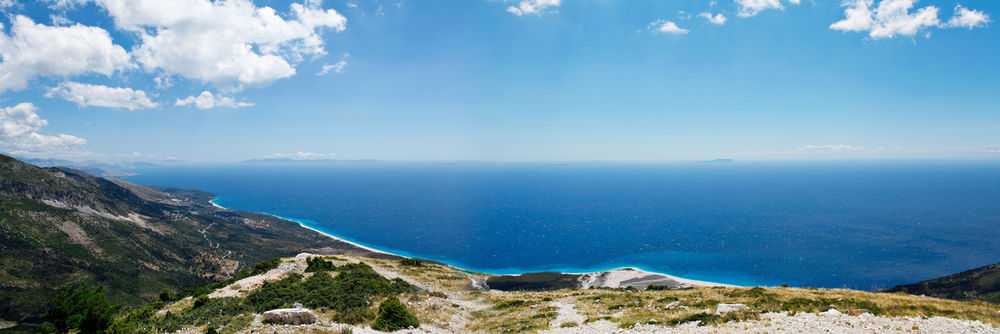












 Vlora-Saranda route in Southwestern Albania along the Albanian Riviera starting from coastal Vlorë into Llogara Pass and along the Ceraunian Mountains
Vlora-Saranda route in Southwestern Albania along the Albanian Riviera starting from coastal Vlorë into Llogara Pass and along the Ceraunian Mountains Rreshen-Kalimash motorway connecting Albania with Kosovo between mountains along the Fan River Valley in Northern Albania
Rreshen-Kalimash motorway connecting Albania with Kosovo between mountains along the Fan River Valley in Northern Albania  Tirana-Elbasan-Pogradec route along the Shkumbin River valley and Ohrid Lake in central Albania
Tirana-Elbasan-Pogradec route along the Shkumbin River valley and Ohrid Lake in central Albania
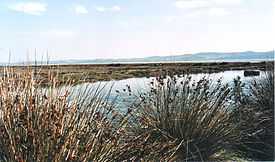






.jpg)
.jpg)


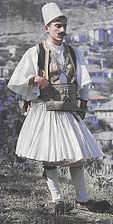



.jpg)




